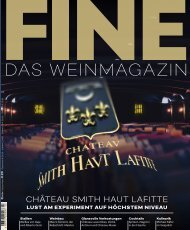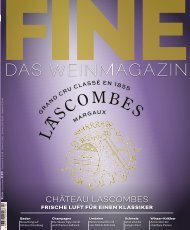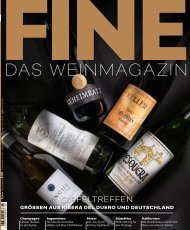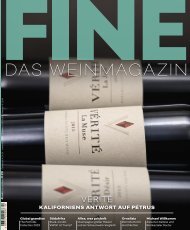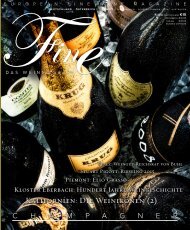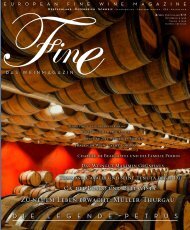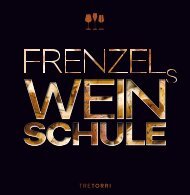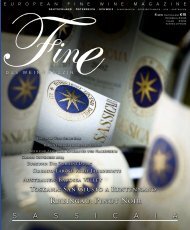Château Mouton Rothschild - Wein & Kunst 1924/1945-2011
Das Chateau Mouton-Rothschild in Pauillac bei Bordeaux ist eines der berühmtesten Weingüter der Welt und ein Mythos der Weinbranche. Neben dem weltweiten Siegeszug seiner Weine mit höchster Qualität ist das unverwechselbare Markenzeichen von Mouton-Rothschild das von weltberühmten Künstlern gestaltete Weinetikett. Große Namen sind hierbei Pablo Picasso, Salvador Dalí, Andy Warhol, Niki de Saint Phalle und viele mehr. "Chateau Mouton Rothschild - Wein & Kunst 1924/1945-2011 Tasting & Art" enthält die Beschreibung jedes Jahrganges und die Fotografie seines jeweils einzigartigen Etiketts. Für den interessierten Leser und Weinkenner finden sich darüber hinaus viele besondere Hintergrundinformationen und Details zur Geschichte des Weingutes und seiner Weine. Im November erscheint die langersehnte Erweiterung mit den Jahrgängen 2004 – 2011. Ein Buch für alle Kunstinteressierten, ein Muss für alle Weinliebhaber!
Das Chateau Mouton-Rothschild in Pauillac bei Bordeaux ist eines der berühmtesten Weingüter der Welt und ein Mythos der Weinbranche. Neben dem weltweiten Siegeszug seiner Weine mit höchster Qualität ist das unverwechselbare Markenzeichen von Mouton-Rothschild das von weltberühmten Künstlern gestaltete Weinetikett. Große Namen sind hierbei Pablo Picasso, Salvador Dalí, Andy Warhol, Niki de Saint Phalle und viele mehr.
"Chateau Mouton Rothschild - Wein & Kunst 1924/1945-2011 Tasting & Art" enthält die Beschreibung jedes Jahrganges und die Fotografie seines jeweils einzigartigen Etiketts. Für den interessierten Leser und Weinkenner finden sich darüber hinaus viele besondere Hintergrundinformationen und Details zur Geschichte des Weingutes und seiner Weine. Im November erscheint die langersehnte Erweiterung mit den Jahrgängen 2004 – 2011.
Ein Buch für alle Kunstinteressierten, ein Muss für alle Weinliebhaber!
Erfolgreiche ePaper selbst erstellen
Machen Sie aus Ihren PDF Publikationen ein blätterbares Flipbook mit unserer einzigartigen Google optimierten e-Paper Software.
<strong>Wein</strong> & <strong>Kunst</strong><br />
<strong>1924</strong>/<strong>1945</strong>-<strong>2011</strong><br />
Wine &-Art<br />
Tre Torri
Kein anderes Volk als die Franzosen hat es besser verstanden, ein so vergängliches Konsumprodukt<br />
wie <strong>Wein</strong> zum Bestandteil der Hochkultur zu stilisieren. Als besonderer Experte der französischen<br />
<strong>Wein</strong>kultur zeigte sich bereits Kaiser Napoleon III., der anlässlich der Pariser Weltausstellung<br />
1855 eine Klassifizierung der damals schon im In- und Ausland hochgeschätzten Rotweine aus<br />
den Bordeaux-Regionen Médoc und Graves anordnete. So wurden von Fachleuten in einer<br />
Blindverkostung, bei der den unparteiischen Prüfern die Identitäten der <strong>Wein</strong>e verborgen blieben,<br />
ungefähr 60 verschiedene <strong>Wein</strong>e bekannter <strong>Château</strong>x in fünf Qualitätskategorien eingeteilt.<br />
Hat man auf der Autofahrt den Stau rund um Bordeaux hinter sich gelassen und biegt Richtung<br />
Norden ins Médoc ab, fällt die Orientierung zwischen den weltberühmten <strong>Château</strong>x leicht:<br />
Rechts liegt <strong>Château</strong> Palmer, links Talbot, rechts Margaux, links Latour. Angekommen<br />
in Pauillac, weist an jeder Kreuzung ein Pfeil den Weg Richtung <strong>Château</strong> <strong>Mouton</strong> <strong>Rothschild</strong>.<br />
Leidenschaft, Tradition und Innovation haben die beeindruckende Entwicklung des <strong>Wein</strong>guts<br />
<strong>Château</strong> <strong>Mouton</strong> <strong>Rothschild</strong> seit dem frühen 20. Jahrhundert geprägt und es zur weltweiten Legende<br />
werden lassen. Wurden früher die <strong>Wein</strong>e <strong>Mouton</strong> <strong>Rothschild</strong>s als pures Konsumgut gekauft, so<br />
werden sie heute als Luxusgut wahrgenommen, für das die Kunden bereit sind, höchste Preise – vor<br />
allem auch für den Markennamen – zu bezahlen. Beim Verkauf eines Luxusguts sind zwei<br />
Dinge von essentieller Bedeutung: Marketing und Präsentation. Gerade auf diesen Gebieten hat<br />
<strong>Mouton</strong> <strong>Rothschild</strong> schon seit jeher Maßstäbe gesetzt.<br />
Vorwort<br />
<strong>Château</strong> <strong>Mouton</strong> <strong>Rothschild</strong> in Pauillac bei Bordeaux verkörpert seit<br />
über 150 Jahren wie kein zweites <strong>Wein</strong>gut die Attribute Perfektion und<br />
Innovation. <strong>Mouton</strong> steht als absoluter Mythos in der <strong>Wein</strong> branche.<br />
Dass sich die große Familientradition der <strong>Rothschild</strong>s mit einem<br />
ge hörigen Schuss Stilbewusstsein, Exzentrik und <strong>Kunst</strong> verständnis vereinigt,<br />
wird dem ehrfürchtig staunenden <strong>Wein</strong> kenner spätes tens bewusst,<br />
wenn er eine Flasche <strong>Mouton</strong> in der Hand halten und einen ersten<br />
Schluck eines Premier Grand Crus trinken darf. Als Baron Philippe<br />
de <strong>Rothschild</strong> 1922 die Leitung des <strong>Wein</strong>guts übernahm, begann der<br />
weltweite Sieges zug <strong>Mouton</strong>s. An erster Stelle waren es die großartigen<br />
<strong>Wein</strong>e, die für Furore sorgten. Doch der Baron setzte weitere Maßstäbe,<br />
indem er die <strong>Château</strong>-Abfüllung, die Lagerung in eigenen Kellern und<br />
ab <strong>1924</strong> die besondere Etikettierung der <strong>Wein</strong>e einführte. So entstand<br />
der stil bildende Qualitätsbegriff »Mise en bouteille au <strong>Château</strong>«, und<br />
die außergewöhnlich guten <strong>Wein</strong>e <strong>Mouton</strong>s bekamen ein eigen ständiges<br />
Gesicht. Die Idee des Barons, die Etiketten für <strong>Mouton</strong> von internationalen<br />
und bedeutenden Künstlern gestalten zu lassen, führte dazu,<br />
dass sie einerseits zum unverwechselbaren Erkennungsbild der Marke<br />
<strong>Mouton</strong> <strong>Rothschild</strong> und andererseits zu weltweit gesuchten Sammlerstücken<br />
wurden.<br />
»<strong>Château</strong> <strong>Mouton</strong> <strong>Rothschild</strong> – <strong>Wein</strong>probe & <strong>Kunst</strong> <strong>1924</strong> /<strong>1945</strong>–2003« –<br />
der Gedanke, alle Jahrgangsweine <strong>Mouton</strong>s mit Künstler etiketten in<br />
einer einzigartigen Probe zu verkosten, ist besonders reizvoll. Nur<br />
äußerst selten werden Proben in solch einem großen Rahmen überhaupt<br />
durchgeführt. Das Ergebnis einer <strong>Wein</strong>probe ist immer von der Präsentation<br />
der <strong>Wein</strong>e, der Geschichte ihrer Herkunft und der Lagerung<br />
abhängig. Unterschiedliche Proben liefern unterschiedliche Ergebnisse,<br />
und eine <strong>Wein</strong>probe kann nur als Momentaufnahme verstanden werden.<br />
Finanzieller Aufwand und ein Mangel an Vollständig keit der Jahrgangsweine<br />
verhindern normalerweise eine so außer gewöhnliche Probe.<br />
Deshalb waren wir umso begeisterter, als wir von dem bekannten <strong>Wein</strong>sammler<br />
Karl-Heinz Wolf die Einladung zu einer Horizontalprobe der<br />
<strong>Mouton</strong> Jahrgänge <strong>1945</strong>–2003 im März 2006 am Attersee in Österreich<br />
erhielten. Es war uns eine Ehre, dass wir den berühmten Autoren<br />
und <strong>Wein</strong>experten Pekka Nuikki aus Finnland dafür gewinnen konnten,<br />
diese Probe mit seinen Verkostungsnotizen für uns zu dokumentieren.<br />
Dazu kommt für die Neuauflage unseres Buches »<strong>Château</strong> <strong>Mouton</strong><br />
<strong>Rothschild</strong> <strong>Wein</strong> & <strong>Kunst</strong> <strong>1924</strong> / <strong>1945</strong>–<strong>2011</strong>« die Bewertung der Jahrgänge<br />
2004–<strong>2011</strong>. Diese <strong>Wein</strong>e wurden von der Fine Das <strong>Wein</strong> magazin<br />
Redaktion verkostet und kommentiert.<br />
Tre Torri Verlag im August 2014<br />
Unlike any other country, the French have managed to elevate as transitory a product as wine as<br />
an essential part of their culture. Emperor Napoleon III was already an expert on French wine<br />
culture, evident in his order to create a classification of the popular wines from the Bordeaux<br />
regions Médoc and Graves, on the occasion of the Paris World Fair in 1855. 60 wines from wellknown<br />
<strong>Château</strong>x were subjected to a blind degustation, in which independent experts did not know<br />
the name of the wine they tasted, and then divided into five quality categories.<br />
Once you have left the traffic jam of Bordeaux behind you and continue north into the Médoc, it is<br />
easy to find your way among the world-famous <strong>Château</strong>x: <strong>Château</strong> Palmer to the right, Talbot to<br />
the left, Margaux to the right, Latour to the left. When you arrive in Pauillac, every intersection<br />
has a sign pointing out the direction of <strong>Château</strong> <strong>Mouton</strong> <strong>Rothschild</strong>.<br />
Passion, tradition and innovation were the defining characteristics in the impressive development<br />
of the vineyard of <strong>Château</strong> <strong>Mouton</strong> <strong>Rothschild</strong> since the early 20ths century and turned it into an<br />
international legend. While the <strong>Mouton</strong> <strong>Rothschild</strong> wines used to be sold for simple consumption,<br />
today they are perceived as luxury goods that fetch top prices, especially for the brand name. For<br />
the sale of a luxury item, two things are essential: marketing and presentation. In these areas,<br />
<strong>Mouton</strong> <strong>Rothschild</strong> has always been setting the standards.<br />
Foreword<br />
For more than 150 years, <strong>Château</strong> <strong>Mouton</strong> <strong>Rothschild</strong> located in<br />
Pauillac near Bordeaux embodies the attributes of perfection and innovation<br />
like no other wine-growing estate. In the wine business, <strong>Mouton</strong><br />
equals an absolute myth. The great <strong>Rothschild</strong> family tradition coupled<br />
with a proper dash of confidence in style, eccentricity, as well as the<br />
appreciation of the arts, comes to light to the reverent and marvelling<br />
wine connoisseur only when holding a bottle of <strong>Mouton</strong> in his hand<br />
to taste the first sip of a Premier Grand Crus. In 1922, when Baron<br />
Philippe de <strong>Rothschild</strong> took over the wine-growing estate, the worldwide<br />
triumphal procession for <strong>Mouton</strong> took its course. First and foremost,<br />
it was the great wines that were a furore. However, the Baron<br />
set new benchmarks by introducing the <strong>Château</strong> bottling, the storage<br />
within his own cellars and, from <strong>1924</strong> onwards, he introduced the<br />
extra ordinary labelling of the wines. This is where the quality term of<br />
“Mise en bouteille au <strong>Château</strong>” was coined and along with it, the exceptionally<br />
good wines reached remarkable independence. Baron Philippe<br />
de <strong>Rothschild</strong>’s idea of having internationally renowned artists design<br />
his wine labels lead to an unmistakable recognition of the <strong>Mouton</strong><br />
<strong>Rothschild</strong> brand, all of which have quickly become a highly desired collector’s<br />
item.<br />
3<br />
“<strong>Château</strong> <strong>Mouton</strong> <strong>Rothschild</strong>–Tasting & Art <strong>1924</strong> /<strong>1945</strong>–2003”–<br />
The conception of showcasing the artists’ labels during the unique tasting<br />
of a vintage wine has been especially appealing. These large-scale<br />
tasting ceremonies only happen on very rare occasions. Knowing that<br />
the result of a wine tasting ceremony depends on the presentation of the<br />
wine, its history, its provenance, and its storage means that differing wine<br />
tastings offer differing results, transforming each into a snapshot experience.<br />
It often is the financial limitations and the lack of complete-ness<br />
of a vintage wine that hinders such an extra ordinary tasting experience.<br />
Therefore, we were very excited when we received an invitation from<br />
the well-known collector of fine wines Karl-Heinz Wolf, from Attersee,<br />
Austria, to join him in March 2006 for a horizontal tasting of the <strong>Mouton</strong><br />
vintages <strong>1945</strong>–2003. We were also delighted when the famous author<br />
and wine expert Pekka Nuikki from Finland agreed to record his tasting<br />
notes of this historical event for our book “ <strong>Château</strong> <strong>Mouton</strong> <strong>Rothschild</strong>–<br />
Tasting & Art <strong>1924</strong>/<strong>1945</strong>–2003”.<br />
The new edition of our book is extended by the rating of the vintages<br />
2004–<strong>2011</strong>. These wines were tasted and commented by the editorial<br />
department of Fine Das <strong>Wein</strong>magazin.<br />
Tre Torri Publishing, August 2014
<strong>Mouton</strong>-Wappen im Grand Chai von <strong>Mouton</strong> <strong>Rothschild</strong><br />
Coat of arms in the chai of <strong>Mouton</strong> <strong>Rothschild</strong><br />
Petit <strong>Mouton</strong><br />
4<br />
5
Jean Carlu > 24 <<br />
•<strong>1924</strong>•<br />
Average weather conditions in the spring, not much better in the<br />
summer, unusual amount of rain in the summer months.<br />
Finally, good weather in September, a lot of sunshine. The nice<br />
early autumn allowed for fine grapes to grow after all.<br />
Decant 1 hour/ Glass 1 hour<br />
Excellent-looking bottle with the label in mint condition. Level top-shoulder,<br />
decanted just one hour before tasting. Very good, dark, deep and mature colour.<br />
Intense looking. A fabulous, decadent nose of blackberries, mint, earth and<br />
tobacco. Opened fully in 15 minutes. The palate was beautifully balanced<br />
with fresh acidity and, like all the great wines, got better and better in the<br />
glass. The tannins were smooth and spirited. A complex and elegant wine with<br />
multilayered fruits and a long, clean finish.<br />
Unquestionably a top class <strong>Mouton</strong>. An epochal wine in many ways!<br />
95 points; Tasted three times / last tasted 1/2007 Drink now!<br />
•••<br />
Tasting on October 14, 1985<br />
Perfect colour, elegant, mint, cassis, at first unexpectedly youthful, then<br />
increasingly lasting – a great wine.<br />
Tasting on September 22, 1985<br />
Mature colour, mature nose, mature palate — completely at its apex, fabulous;<br />
classic cabernet tones, mint, cassis.<br />
Eher durchschnittliche Wetterbedingungen im Frühjahr, auch<br />
im Sommer keine Besserung, mit ungewöhnlich viel Regen in den<br />
Sommermonaten.<br />
Erst im September endlich schönes Wetter, viel Sonnenschein.<br />
Der schöne Frühherbst ließ doch noch gute Trauben gedeihen.<br />
Degustation• Notes / Notizen<br />
Dekantieren 1 Stunde/Glas 1 Stunde<br />
Flasche in ausgezeichnetem Zustand mit Etikett in tadellosem Zustand. Füllhöhe<br />
top-shoulder (ts), dekantiert nur eine Stunde vor der Probe. Sehr gute dunkle,<br />
tiefe und reife Farbe. Intensives Aussehen. Eine fabelhafte, dekadente Nase<br />
von Brombeeren, Minze, Erdnoten und Tabak. Voll geöffnet nach 15 Minuten.<br />
Am Gaumen wunderbar ausgeglichen mit frischer Säure, wurde wie alle großen<br />
<strong>Wein</strong>e im Glas immer besser. Die Tannine waren weich und feurig. Ein komplexer,<br />
eleganter <strong>Wein</strong> mit facettenreicher Frucht und langem, sauberem Abgang.<br />
Zweifellos ein erstklassiger <strong>Mouton</strong>. In mancher Hinsicht ein epochaler <strong>Wein</strong>!<br />
95 Punkte; dreimal verkostet / letzte Probe 1/2007 Sofort trinken!<br />
•••<br />
Probe am 14.10.1985<br />
Perfekte Farbe, elegant, Minze, Cassis, zunächst unerwartet jugendlich,<br />
dann zunehmend bleibend – ein großer <strong>Wein</strong>.<br />
Probe am 22.09.1985<br />
Reife Farbe, reife Nase, reifer Gaumen – voll auf dem Höhepunkt, traumhaft;<br />
klassische Cabernetnoten, Minze, Cassis.<br />
45<br />
46<br />
47<br />
48<br />
49<br />
50<br />
51<br />
52<br />
53<br />
54<br />
55<br />
56<br />
57<br />
58<br />
59<br />
60<br />
61<br />
62<br />
63<br />
64<br />
65<br />
66<br />
67<br />
68<br />
69<br />
70<br />
71<br />
72<br />
73<br />
74<br />
75<br />
76<br />
77<br />
78<br />
79<br />
80<br />
81<br />
82<br />
83<br />
84<br />
85<br />
86<br />
87<br />
88<br />
89<br />
90<br />
91<br />
92<br />
93<br />
94<br />
95<br />
96<br />
97<br />
98<br />
99<br />
00<br />
01<br />
02<br />
03<br />
04<br />
05<br />
06<br />
07<br />
08<br />
09<br />
10<br />
11
Jean Carlu > 24 <<br />
The artist Jean Carlu was born in 1900, coming from a respected architect’s family.<br />
Although he worked as a painter, sculptor and architect, he was a graduate of the<br />
famous Ecole des Beaux-Arts, specializing early on in graphics and lithography.<br />
At the age of 18, he became a focus of public attention and was honoured by a jury<br />
surrounding the well-known graphic designer Cappiello as France’s designer of the<br />
year.Tragically, he lost his right arm in a car accident that same year. Even with the<br />
severe setback of the injury, the young graphic artist decided to continue his career<br />
despite the handicap and learned his craft practically from scratch. Many of Carlu’s<br />
posters and placards express his involvement in politics and his free thinking. Jean<br />
Carlu, also called the »musketeer of posters«, worked for the peace and resistance<br />
movement and created the sensational poster series »Stop Hitler Now« in 1940,<br />
designed to inspire the fight against National Socialism. His graphic work can be<br />
ascribed to Cubism and later to Surrealism under the influence of André Breton.<br />
In 1926, Jean Carlu designed the first artist label for <strong>Mouton</strong> <strong>Rothschild</strong> for the<br />
<strong>1924</strong> vintage, thus doing pioneering work for the series of exceptional works of art<br />
on the <strong>Mouton</strong> labels.<br />
The Very First Artist Label<br />
Jean Carlu<br />
Das erste Künstleretikett überhaupt<br />
Der Künstler Jean Carlu wurde im Jahr 1900 geboren, er stammte aus einer angesehenen<br />
Architektenfamilie. Obwohl er auch als Maler, Bildhauer und Architekt<br />
arbeitete, spezialisierte er sich als Absolvent der berühmten Ecole des Beaux-Arts<br />
früh auf Grafik und Lithographie.<br />
Schon mit 18 Jahren rückte er in das Interesse der Öffentlichkeit und wurde von<br />
einer Jury rund um den bekannten Grafikdesigner Cappiello als Frankreichs<br />
„Designer des Jahres» ausgezeichnet. Tragischerweise verlor er im selben Jahr bei<br />
einem Verkehrsunfall seinen rechten Arm. Durch die Folgen des Unfalls zurückgeworfen,<br />
entschied sich der junge Grafiker trotz seines Handicaps, seine Karriere<br />
fortzusetzen und sein Handwerk praktisch neu zu erlernen.<br />
Viele Poster und Plakate Carlus zeugen von seinem politischen Engagement und<br />
freiheitlichen Denken. Jean Carlu, auch „Musketier des Plakats» genannt, setzte<br />
sich für die Friedens- und Widerstandsbewegung ein und gestaltete 1940 die aufsehenerregende<br />
Plakatreihe „Stop Hitler now», die zum Kampf gegen den Nationalsozialismus<br />
aufrütteln sollte. Sein grafisches Werk ist dem Kubismus und später,<br />
unter dem Einfluss von André Breton, dem Surrealismus zuzuordnen.<br />
1926 gestaltete Jean Carlu das erste Künstleretikett für <strong>Mouton</strong> <strong>Rothschild</strong> für<br />
den <strong>1924</strong>er Jahrgang und leistete damit die Pionierarbeit für die weitere Reihe von<br />
herausragenden Künstlerarbeiten auf den Etiketten <strong>Mouton</strong>s.<br />
45<br />
46<br />
47<br />
48<br />
49<br />
50<br />
51<br />
52<br />
53<br />
54<br />
55<br />
56<br />
57<br />
58<br />
59<br />
60<br />
61<br />
62<br />
63<br />
64<br />
65<br />
66<br />
67<br />
68<br />
69<br />
70<br />
71<br />
72<br />
73<br />
74<br />
75<br />
76<br />
77<br />
78<br />
79<br />
80<br />
81<br />
82<br />
83<br />
84<br />
85<br />
86<br />
87<br />
88<br />
89<br />
90<br />
91<br />
92<br />
93<br />
94<br />
95<br />
96<br />
97<br />
98<br />
99<br />
00<br />
01<br />
02<br />
03<br />
04<br />
05<br />
06<br />
07<br />
08<br />
09<br />
10<br />
11
24<br />
•1956•<br />
In Médoc, 8 cm of snow fell in February. This was the coldest winter<br />
since 1709. The vines suffered severe frost damage, the late and<br />
insufficient blossom didn’t allow for a good harvest. Wet and cold<br />
into the second half of August. Heavy rain in September, too.<br />
Decant 15 minutes/Glass 1 hour<br />
Fill level into neck. Fairly deep, darkish brown colour. Simple cedary nose<br />
with some mint and dried fruit. A basic wine with gentle acids and soft tannins.<br />
Also a bit vegetal and slightly astringent on the palate. A lot of alcohol in the<br />
aftertaste. An unbalanced wine with a one-dimensional taste.<br />
Not to be stored or tasted any longer.<br />
65 points; Tasted twice / Last tasted 11/2004 Drink now<br />
•••<br />
Tasting on June 17, 2006<br />
Beautiful, aromatic nose, extreme acidity on the palate, vegetable scent –<br />
just mediocre — past the point.<br />
Im Médoc lagen im Februar 8 cm Schnee. Das war der kälteste Winter<br />
seit 1709. Die Rebstöcke erlitten schwere Frostschäden, späte und<br />
nicht ausreichende Blüte ließ keinen großen Ertrag mehr zu.<br />
Nässe und Kälte bis in die zweite Hälfte des August. Viel Regen auch<br />
im September.<br />
Degustation• Notes / Notizen<br />
Dekantieren 15 Minuten/Glas 1 Stunde<br />
Füllhöhe in den Flaschenhals hinein. Recht tiefe, dunkel bräunliche Farbe. Einfache<br />
zedrige Nase mit etwas Minze und getrockneten Früchten. Ein einfacher <strong>Wein</strong><br />
mit milder Säure und weichen Tanninen. Leicht vegetabil und etwas säuerlich am<br />
Gaumen. Viel Alkohol im Nachgeschmack. Ein wenig ausgeglichener <strong>Wein</strong> mit<br />
eindimensionalem Geschmack. Sollte nicht länger gelagert oder verkostet werden.<br />
65 Punkte; zweimal verkostet / letzte Probe 11/2004 Sofort trinken<br />
•••<br />
Probe am 17.06.2006<br />
Schöne, aromatische Nase, am Gaumen extreme Säure, vegetabiler Geruch, nur<br />
mittelmäßig – über den Punkt.<br />
45<br />
46<br />
47<br />
48<br />
49<br />
50<br />
51<br />
52<br />
53<br />
54<br />
55<br />
Pavel Tchelitchew > 56 <<br />
57<br />
58<br />
59<br />
60<br />
61<br />
62<br />
63<br />
64<br />
65<br />
66<br />
67<br />
68<br />
69<br />
70<br />
71<br />
72<br />
73<br />
74<br />
75<br />
76<br />
77<br />
78<br />
79<br />
80<br />
81<br />
82<br />
83<br />
84<br />
85<br />
86<br />
87<br />
88<br />
89<br />
90<br />
91<br />
92<br />
93<br />
94<br />
95<br />
96<br />
97<br />
98<br />
99<br />
00<br />
01<br />
02<br />
03<br />
04<br />
05<br />
06<br />
07<br />
08<br />
09<br />
10<br />
11
24<br />
Pavel Tchelitchew (1898–1957), who came from a Russian aristocratic family, studied<br />
at the Academy of the Arts in Kiev, before he emigrated to Germany in 1920.<br />
For a few years, he worked as a set designer in Berlin, before moving on to Paris.<br />
His early paintings and drawings were neo-Romantic, his later works rather Surrealist.<br />
He was friends with the protagonists of the Surrealist movement surrounding<br />
André Breton, Yves Tanguy and Max Ernst.<br />
His design for the <strong>Mouton</strong> label, impressive in its technical precision, was one of<br />
his last works shortly before his death. Tchelitchew called the gouache »La tache de<br />
vin«. And, indeed, in the background you can see a wine stain on which the ram,<br />
the crest of arms of Baron Philippe de <strong>Rothschild</strong>, seems to hover in perspective<br />
construction.<br />
The Wine Stain<br />
Pavel Tchelitchew<br />
Der <strong>Wein</strong>fleck<br />
Pavel Tchelitchew (1898–1957), aus einer russischen Aristokratenfamilie stammend,<br />
emigrierte nach seinem Studium an der <strong>Kunst</strong>akademie in Kiew 1920 nach<br />
Deutschland. Er arbeitete für einige Jahre als Bühnenbildner in Berlin, bevor es<br />
ihn weiter nach Paris zog. Seine frühen Bilder und Zeichnungen lassen sich der<br />
Neoromantik zuordnen, sein späteres Werk eher dem Surrealismus. Es verband ihn<br />
eine Freundschaft zu den Protagonisten der surrealistischen Bewegung rund um<br />
André Breton, Yves Tanguy und Max Ernst.<br />
Sein durch große zeichnerische Präzision beeindruckender Entwurf für das <strong>Mouton</strong>-Etikett<br />
war kurz vor seinem Tod eine seiner letzten Arbeiten. Tchelitchew<br />
nannte die Gouache „La tache de vin». Und tatsächlich erkennt man im Bildhintergrund<br />
einen <strong>Wein</strong>fleck, auf dem der Widder, das Wappen Barons Philippe<br />
de <strong>Rothschild</strong>, in perspektivischer Konstruktion zu schweben scheint.<br />
45<br />
46<br />
47<br />
48<br />
49<br />
50<br />
51<br />
52<br />
53<br />
54<br />
55<br />
Pavel Tchelitchew > 56 <<br />
57<br />
58<br />
59<br />
60<br />
61<br />
62<br />
63<br />
64<br />
65<br />
66<br />
67<br />
68<br />
69<br />
70<br />
71<br />
72<br />
73<br />
74<br />
75<br />
76<br />
77<br />
78<br />
79<br />
80<br />
81<br />
82<br />
83<br />
84<br />
85<br />
86<br />
87<br />
88<br />
89<br />
90<br />
91<br />
92<br />
93<br />
94<br />
95<br />
96<br />
97<br />
98<br />
99<br />
00<br />
01<br />
02<br />
03<br />
04<br />
05<br />
06<br />
07<br />
08<br />
09<br />
10<br />
11
24<br />
•2010•<br />
This vintage is recognised as one of the best in Bordeaux, and rightfully so.<br />
Relatively cool for most of the season, the weather eventually found its perfect<br />
equilibrium with sunshine and rain more or less coming just at the right time.<br />
The nose already reveals a compact character and great aromatic complexity.<br />
The dominance of Cabernet Sauvignon, rounded off by just a fraction of<br />
Merlot, is reflected in a peppery, fresh and savoury expression. Cassis and<br />
black cherries are perfectly balanced by a cool acidity and clear crunchy tannins.<br />
A comprehensively elegant wine with a long finish.<br />
98 points; last tasted 06/2014<br />
Degustation• Notes / Notizen<br />
Dieser Jahrgang gilt zur Recht als einer der besten im Bordelais. Die verhältnismäßig<br />
kühle Witterung fand ihre Ponderation dann aber doch in dem idealen<br />
Einfluss der Sonne und dem Regen, der meist zum passenden Zeitpunkt fiel. Schon<br />
in der Nase zeigt der <strong>Wein</strong> seinen kompakten Charakter und seine komplexe<br />
Aromatik. Die Dominanz des Cabernet Sauvignon, der mit einem nur sehr geringen<br />
Anteil von Merlot abgerundet wurde, spiegelt sich in der pfeffrigen, frisch-würzigen<br />
Art wieder. Cassis und schwarze Kirsche passen perfekt zur kühlen Säure am<br />
Gaumen und den klaren, knackigen Tanninen. Umfassende Eleganz mit einem<br />
langen Nachhall.<br />
98 Punkte; letzte Probe 06/2014<br />
45<br />
46<br />
47<br />
48<br />
49<br />
50<br />
51<br />
52<br />
53<br />
54<br />
55<br />
56<br />
57<br />
58<br />
59<br />
60<br />
61<br />
62<br />
63<br />
64<br />
65<br />
66<br />
67<br />
68<br />
69<br />
70<br />
71<br />
72<br />
73<br />
74<br />
75<br />
76<br />
77<br />
78<br />
79<br />
80<br />
81<br />
82<br />
83<br />
84<br />
85<br />
86<br />
87<br />
88<br />
89<br />
90<br />
91<br />
92<br />
93<br />
94<br />
95<br />
96<br />
97<br />
98<br />
99<br />
00<br />
01<br />
02<br />
03<br />
04<br />
05<br />
06<br />
07<br />
08<br />
09<br />
Jeff Koons > 10 <<br />
11
Jeff Koons was born in Pennsylvania, America in 1955. He nearly turned his back<br />
on art as the main interest of his youth in favour of a career as a stock brocker in<br />
Wall Street, but returned to painting, photography and the design of sculptures<br />
in the late 1970s. In the eighties his frequently naïve and often demonstratively<br />
banal creations still managed to find increasing recognition as an expression of<br />
neo-concept art and post-ironic modernism. Even his satirically socio-critical<br />
and anti-consumption artworks inflamed the enthusiasm of experts and collectors<br />
alike and attracted record prices as the pinnacle of artistic expression of the late<br />
twentieth century.<br />
Jeff Koon’s productions are always likely to provoke controversy. The exhibition of<br />
a selection of his outsized sculptures in 2010 in the rooms and park of the Royal<br />
Palace of Versailles did not find the unequivocal approval of the public or the critics.<br />
Despite, or just because of, his reputation as one of the most controversial artists of<br />
the last few decades recent commissions by the Vienna Opera House or BMW bear<br />
testimony to his unbroken popularity.<br />
In his illustration on the label of the 2010 <strong>Mouton</strong> Koons uses the ancient Pompeii<br />
fresco of The Birth of Venus as a foil for his silver line drawing of a boat sailing<br />
under a bright sun. The scene is set between two lines opening towards the top,<br />
vaguely resembling a wine glass. The but minor modification of the classic motif<br />
could lead one to believe that in this instance Koons exercised untypical restraint<br />
out of respect for the venerable <strong>Mouton</strong>.<br />
Label <strong>Château</strong> <strong>Mouton</strong> <strong>Rothschild</strong> 2010<br />
Jeff Koons<br />
Etikett <strong>Château</strong> <strong>Mouton</strong> <strong>Rothschild</strong> 2010<br />
Fast hätte der 1955 in Pennsylvanien, Amerika, geborene Jeff Koons sein von Jugend<br />
an bestehendes Interesse an der <strong>Kunst</strong> für eine Karriere als Börsen-Broker an der<br />
Wall Street verraten – da wendete er sich gegen Ende der siebziger Jahre doch wieder<br />
der Malerei, Fotografie und dem Design von Skulpturen zu. In den Achtzigern<br />
fanden seine oft naiven und manchmal demonstrativ kitschigen Kreationen zunehmend<br />
Anerkennung als Ausdruck der Neo-Konzept-Schule und postironischen<br />
<strong>Kunst</strong>. Selbst seine satirisch angehauchten und konsumkritischen Werke erregten<br />
die Begeisterung von Fachwelt und Sammlern und wurden als Ausdruck der <strong>Kunst</strong><br />
des späten 20. Jahrhunderts zu Höchstpreisen gehandelt.<br />
Jeff Koons Produktionen sind immer dazu geeignet, Kontroversen zu provozieren.<br />
Die Ausstellung einer Auswahl seiner überdimensionalen Skulpturen im Jahre 2010<br />
in den königlichen Gemächern sowie im Park des Schlosses von Versailles fand bei<br />
Publikum und Kritikern nicht den Anklang, den sich die Organisatoren erhofft<br />
hatten.<br />
Obwohl Koons auch deshalb den Ruf als einer der umstrittensten Künstler der<br />
letzten Jahrzehnte genießt, bezeugen Auftragsarbeiten der jüngsten Vergangenheit<br />
für die Wiener Staatsoper oder für BMW doch seine ungebrochene Popularität.<br />
Die in silbernen Strichen gehaltene Darstellung auf dem Etikett nutzt das Fresco<br />
»Geburt der Venus« aus Pompeji als Folie für ein in einem offenen Kelch unter der<br />
strahlenden Sonne segelndes Boot. Das nur leicht verfremdete konservative Motiv<br />
lässt darauf schließen, dass Koons sich bei der Gestaltung aus Ehrfurcht vor dem<br />
großen <strong>Mouton</strong> ungewöhnliche Zurückhaltung auferlegt hat.<br />
24<br />
45<br />
46<br />
47<br />
48<br />
49<br />
50<br />
51<br />
52<br />
53<br />
54<br />
55<br />
56<br />
57<br />
58<br />
59<br />
60<br />
61<br />
62<br />
63<br />
64<br />
65<br />
66<br />
67<br />
68<br />
69<br />
70<br />
71<br />
72<br />
73<br />
74<br />
75<br />
76<br />
77<br />
78<br />
79<br />
80<br />
81<br />
82<br />
83<br />
84<br />
85<br />
86<br />
87<br />
88<br />
89<br />
90<br />
91<br />
92<br />
93<br />
94<br />
95<br />
96<br />
97<br />
98<br />
99<br />
00<br />
01<br />
02<br />
03<br />
04<br />
05<br />
06<br />
07<br />
08<br />
09<br />
Jeff Koons > 10 <<br />
11
Unser besonderer Dank gilt …<br />
… Karl-Heinz Wolf und Pekka Nuikki für die Überlassung ihrer Degustationsnotizen<br />
und die Original-<strong>Château</strong>-<strong>Mouton</strong>-<strong>Rothschild</strong>-<strong>Wein</strong>flaschen.<br />
Impressum<br />
<strong>Château</strong> <strong>Mouton</strong> <strong>Rothschild</strong> – <strong>Wein</strong> & <strong>Kunst</strong> <strong>1924</strong> / <strong>1945</strong>–<strong>2011</strong> Wine & Art<br />
Herausgeber: Ralf Frenzel<br />
Überarbeitete Neuauflage 2014<br />
© 2007 Tre Torri Verlag GmbH, Wiesbaden<br />
www.tretorri.de<br />
Idee, Konzeption und Umsetzung: Tre Torri Verlag GmbH<br />
Art Direction:<br />
Fotografie:<br />
Text:<br />
Englische Übersetzung:<br />
Reproduktion:<br />
Guido Bittner, Wiesbaden<br />
Michael Link, Wiesbaden / Pekka Nuikki, Helsinki / Guido Bittner, Wiesbaden<br />
Oliver Drerup, Berlin / Michael Schmidt, Bad Neuenahr-Ahrweiler<br />
Lisa Soules, Frankfurt / Michael Schmidt, Bad Neuenahr-Ahrweiler<br />
DG Medien GmbH, Heidelberg<br />
Printed in Germany<br />
ISBN: 978-3-944628-39-4<br />
Haftungsausschluss:<br />
Die Inhalte dieses Buches wurden von Herausgeber und Verlag sorgfältig erwogen und geprüft. Dennoch kann eine Garantie nicht übernommen werden.<br />
Die Haftung des Herausgebers bzw. des Verlages für Personen-, Sach- und Vermögensschäden ist ausgeschlossen.





